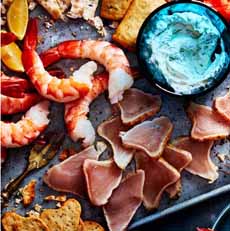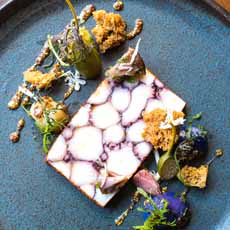TIP OF THE DAY: Seacuterie
|
Every foodie knows charcuterie: meats crafted into pâtés, rillettes sausages, terrines and more. In the U.S., it is served as a first course and often appears on appetizer boards alongside cheeses and cold cuts. But whether for palate preference, avoidance of so much animal fat or pescatarianism, a new trend is redefining charcuterie: seacuterie, an appetizer platter* of seafood. Seacuterie is a new term for smoked and cured fish and shellfish dishes prepared with techniques typically associated with meats. The first example we know of was the salmon pastrami developed by pioneering chef David Burke at Park Avenue Cafe in New York City, in the early 1990s (photo #4—he called it pastrami salmon). It was adopted by other chefs, and led to other fish pastrami, culmimating in the most gorgeous mosaic of octopus pastrami from Chef Markus Glocker at Bâtard in New York City (photo #3). Now, chefs from coast to coast—especially seafood specialists—offer seacuterie plates (photo #2). While you may not be up for making salmon pastrami or octopus pastrami (we couldn’t even find a recipe for it!), you can put together a “seacuterie” board of assorted appetizer fish. We did it for New Year’s Eve—it’s great with champagne and other sparkling wines—and are planning it again for Valentine’s Day. This is not an exercise for the faint of pocket, but you can save money by seeking out frozen seafood and limiting your choices (photo #1). Everything should be easy: nothing in the shell, like crab claws; nothing drippy, like calamari salad. Select five types of seafood. Some suggestions: 1. ARRANGE the items on a large serving platter or board. Some items (capers, olives, salads) will require ramekins or small bowls). 2. GARNISH the platter with sprigs of dill. 3. SET OUT cocktail forks or picks, small spoons (like espresso spoons) and spreaders; plus cocktail plates and napkins. 4. SERVE the breads and crackers on a separate plate or basket, unless you have a jumbo plate that holds everything. |
 [1] You can put together a basic seacuterie board with fresh or frozen seafood (here, formerly frozen shrimp and tuna tataki from Provigo, with dill dip (photo © Provigo).
|
|
|
________________ *A seacuterie platter is different from a plateau de fruits de mer, a platter of shellfish—lobster, oysters, shrimp, etc.—served on a bed of ice, along with condiments such as mignonette sauce, cocktail sauce and lemon wedges. It is usually served on a silver stand instead of a flat plate or platter.
|
||





